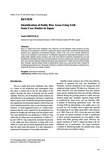Rice is a staple food across Southeast Asia. However, not all Southeast Asian countries are self- sufficient in rice production, and there is significant import-export trade. Foodstuffs and agricultural products have significant environmental impacts, which in the case of rice include demand for water, as rice farming is water-intensive. It is therefore important to understand the dynamics of rice paddy fields. Satellite remote sensing is one of the most effective methods of grasping the area and distribution of farmland. However, East and Southeast Asia have distinct rainy seasons, making clear skies rare and data collection difficult during the growing period in visible and near infrared image data. Synthetic Aperture Radar (SAR) is unaffected by cloud cover, and can thus offer a method of monitoring agricultural areas. This paper introduces a method of identifying paddy rice planted areas using SAR and some case studies in Japan.

